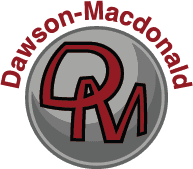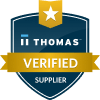Abrasive Profile Guidelines + Blasting Grit Size Chart
About Anchor Abrasives & Sandblasting Grits
Contractors and manufacturers can create specific surface profiles, or anchor abrasives, by blasting the material surface with sand or other gritty particulate matter. Particles rub against the surface, giving it a rough texture of minute peaks and valleys and a greater surface area. This is a vital preparatory step before applying finishes like paint or powder coats and can also be used to clean metal surfaces or remove rust.
In sandblasting processes, technicians use equipment to send dry, loose particulate across the substrate surface at a specified speed and pressure. Not only is it important to use the right power level, but the size and sharpness of the particles also play a critical role in the controlled roughness of the surface.
At Dawson-Macdonald Co. Inc., we offer a wide selection of abrasives and blasting media for your cleaning, finishing, and surface preparation needs. Use our blasting grit size chart below to zero in on the right media for different types of projects.
Importance of Choosing the Right Sandblasting Grit for Your Needs
It’s important to have the right anchor pattern, or peaks and valleys, when sandblasting surfaces. This roughens the surface for finishes and coatings to bind to. The right equipment, settings, and particulate size work together to create a uniform finish.
While differently sized particles will create distinct patterns, selecting smaller or larger particles won’t necessarily produce a finer or rougher surface. Instead, sandblasting technicians need to carefully consider a wide array of factors, including:
- The type of abrasive media being used
- The purpose of roughening the surface (surface preparation, finishing, or cleaning)
- Wet vs. dry blasting
- Direct pressure vs. siphon blasting techniques
Any variation in these factors will result in a very different pattern on the surface of the workpieces, which means having to redo the job. We work with equipment operators and businesses to help them choose the right sandblasting grit and get the desired results the first time around.
You will also need to decide what grit size and material you want to use. Most sandblasting substrate is sorted into categories based on the materials’ mils count. “Mils” is a unit of measurement equal to 1/1000th of an inch.
Rather than measuring the particle size, it measures the size of the etch line or divet on the substrate’s surface. For example, 1-mil particulate creates etches with a 1/1000th of an inch in fineness. A G80 steel grit, 80 mesh garnet, or 100 aluminum oxide can easily achieve the desired divet size.
The width of the blast media and the hardness or physical characteristics of the material determine the possible mils. As a result, contractors can’t just use smaller or larger particulates; the process of selecting materials for different anchor abrasive profiles is generally more complex.
Mil Anchor Pattern Blasting Grit Size Chart
Below, you’ll find popular blasting media options based on the mil profile they provide:
![]() Mil Anchor Pattern Blasting Grit Size Chart
Mil Anchor Pattern Blasting Grit Size Chart
Find the Right Sandblasting Grit for Your Application With Dawson-Macdonald
Choosing the right mil anchor pattern blasting grit size is the first step to adequately prepping or finishing the surface of workpieces. Our blasting grit size chart can help determine which options fit your business needs. At Dawson-Macdonald, we also provide expert support and a range of grit options, so you can complete your next project with confidence.
Reach out to our customer service team today to learn more about our products and services or to place your order.


